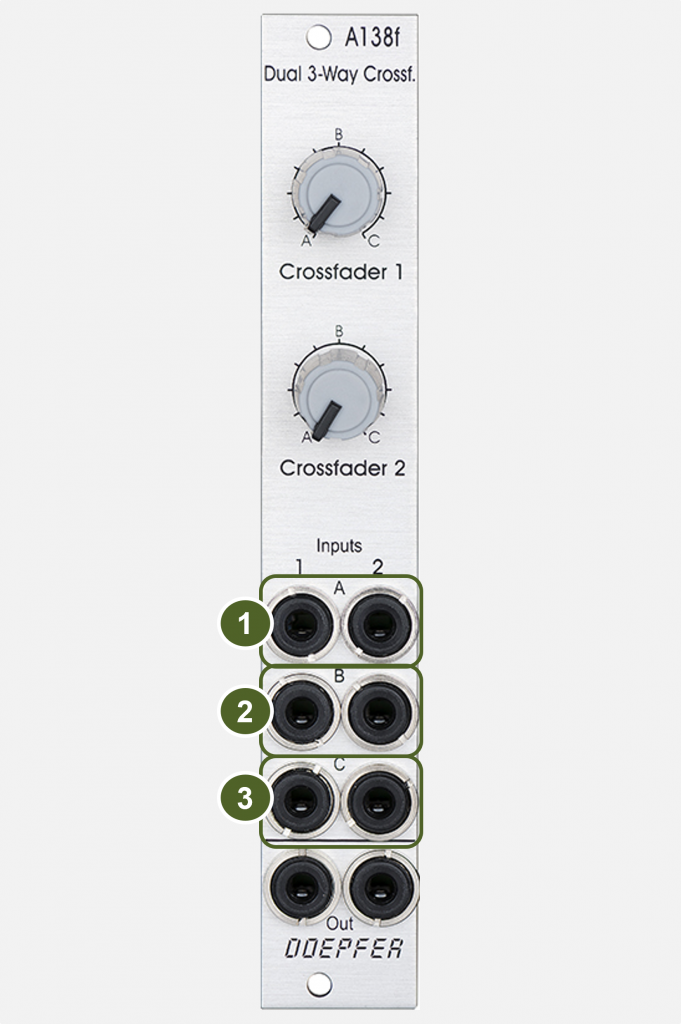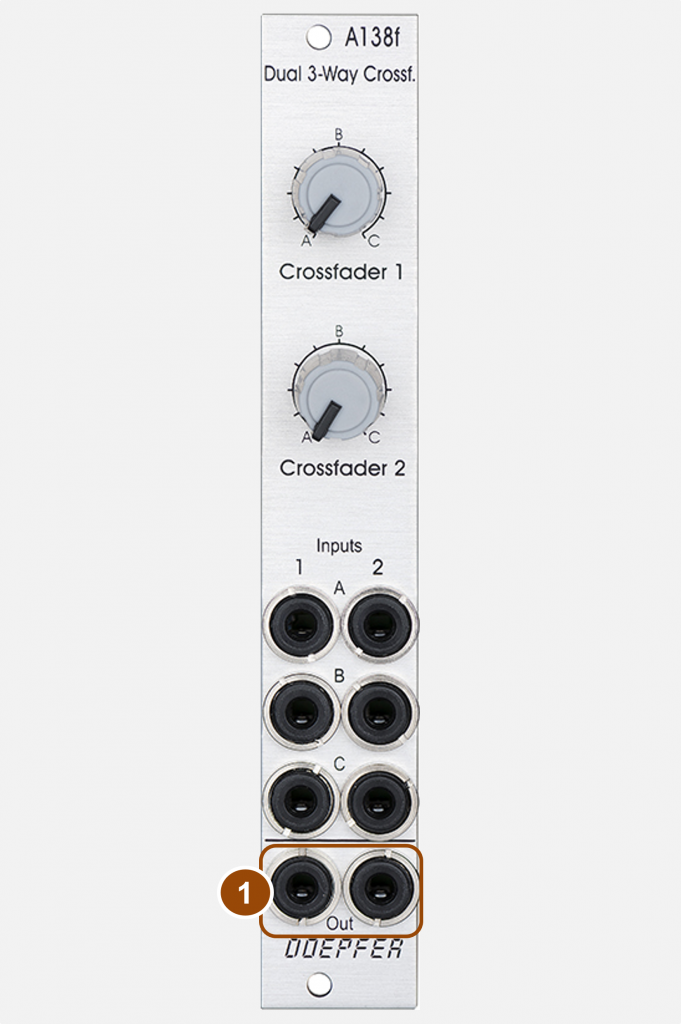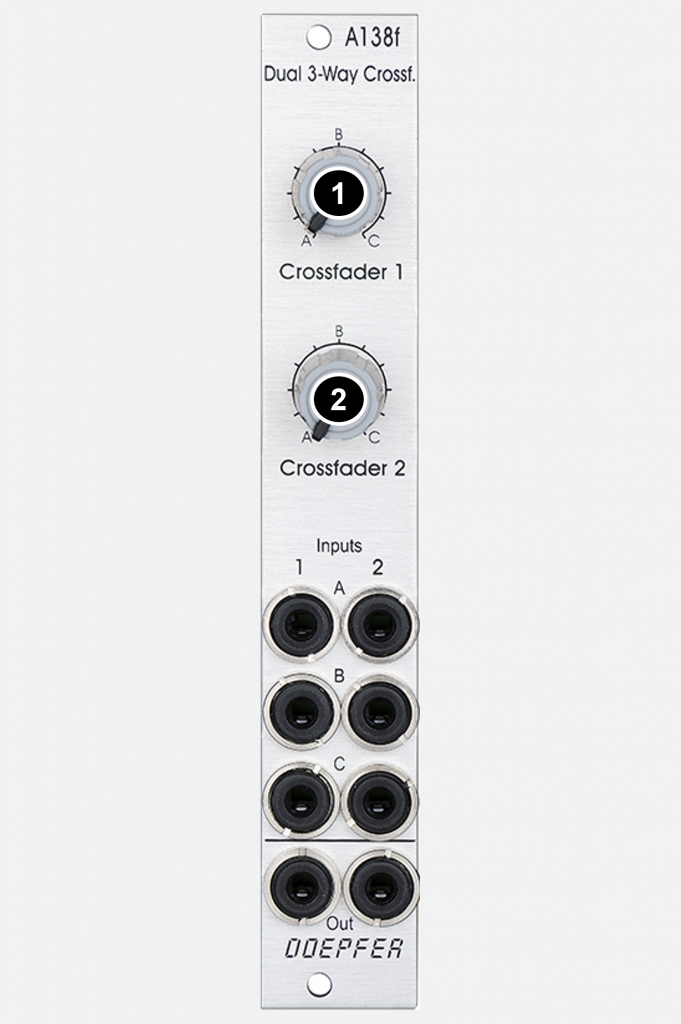
The A-138f is a small, dual, three-way crossfader. “Three-way” here means that we have three possible input signals and one output signal. You will look in vain for the extremely sophisticated options of the A-138e, which unfortunately is no longer manufactured. The A-138f simply fades between two signals “A” and “B” and then (from the 12 o’clock position of the controller) between “B” and “C”. And the whole thing is available twice in the module. Complete.
But the A-138f also has a user interface that you can understand at first glance and for which you don’t have to lock yourself in for days with the manual. With only 4 HP, the “Slim Line” module is also very small and is therefore ideal for smaller setups, which can also be operated completely intuitively live and in poor lighting. I would still never give up my two A-138e, but there are other reasons for that.
Unlike most other new Doepfer modules, we don’t find any other configuration options on the board. But that also fits the module, where everything is very simple and clear, and you never have to think about what the thing is actually doing at the moment.
User interface
Inputs:

Each of the two independent crossfaders has three inputs “A”, “B” and “C”, between which you can fade continuously. The module can be used for audio signals as well as for control voltages (e.g. LFO, envelope and random number generator). For example, crossfader 1 can be used to crossfade three waveforms of a VCO, and crossfader 2 for three modulation sources.
- A: The two “A” inputs.
- B: The two “B” inputs.
- C: The two “C” inputs.
The three inputs are not normalized: if not all inputs are occupied, the unused input is treated as “mute”. So if only “A” and “C” are occupied, there will be a crossfade between input “A”, silence and input “C”.
Outputs:

- Out: Outputs of the two crossfaders, which output a mix of the respective inputs “A” and “B” or “B” and “C” above.
Controls:

- Crossfader 1: The mixing ratio in Crossfader 1 is set manually here. Between control positions A and B a mix of the two inputs “A” and “B” on the left side, between control positions B and C a mix of the two input signals of “B” and “C” on the left side. With the controller at the far left on A, only the input signal from “A” is output, at the “12 o’clock position” B only the input signal from “B” and at the far right on C only the input signal from “C”. The controller snaps in slightly in the middle position (B), practical!
- Crossfader 2: Like “Crossfader 1”, but for the three inputs “A”, “B” and “C” on the right side.
Possible uses
A crossfader is actually a very simplified mixer. Instead of several controls for the individual input signals, a crossfader has only one control that regulates the levels of the signals together. So if you already have a mixer (and who doesn’t have one), then you can basically save yourself a crossfader and screw something really great into the rack instead?
This is where the most important building block of every modular system comes into play: the person who sits in front of it and hopefully does totally creative and musical things with this heap of technology. And here we have a few serious technical limitations: Unfortunately, such a person only has two hands with which he or she can screw on the box at the same time. So when it comes to smoothly fading two signals into each other, you need two hands for a mixer, and only one for a crossfader – unless everything is already automated via control voltages, but then we talk about other rack space requirements and modularist budgets. And even then, it is not uncommon for the situation to arise where everything on CV-controlled mixers is already built into the patch, but you still want to crossfade other audio or modulation sources. For such cases, the 4HP of the A-138f is pretty well laid out rack space.
Another scenario is mixing ratios from several audio or modulation sources, which should be as equal as possible. Anyone who, like me, has been smitten by the virus of the polyphonic modules will know what I mean. Let’s say I want to mix two polyphonic A-111-4 VCOs and optionally an A-111-4 VCO and a noise generator as inputs to an A-105-4 VCF. Many use the A-138n narrow mixers for this: The mixers have four inputs that can be mixed at will, so for a polyphonic setup you need four such A-138n mixers. Only needs 16TE space, that’s still manageable. The disadvantage of this is that you have to operate no fewer than 8 controls – in different directions – for all changes in the mixing ratio, e.g. of two A-111-4. If you take two A-138f instead, then there are only four controllers. And with a little practice, you can adjust two of these controls together with one hand, since they all have to be moved in the same direction.
Alternatives
A-138e Quad Three-Way Crossfader / Mixer / Polarizer
Unfortunately, the most obvious alternative is no longer manufactured: The A-138e was a monster of possible configurations – polarizer, two or three-way crossfader, attenuator, inverter, all quad in a fairly inexpensive module, with the option to use it all in the form of a three-channel mixer . The big snag here: This complexity also needs some training time. You have to know what you want and how to get it. With 16HP, the module needs twice as much space for its four crossfaders as two A-138f.
A-134-2 Dual VC Crossfader
Here we also have an extremely space-saving 4TE module that even works voltage-controlled. The A-134-2 has two independent crossfaders like the A-138f, but they can optionally interact with each other (via switch sockets or jumpers on the circuit board). Disadvantages compared to our A-138f: This is only a two-way crossfader and not a three-way crossfader like the A-138f. There is no manual control, so we need at least two control voltage sources to be able to operate the module at all. In addition, the complex interaction of the two crossfaders also requires a certain amount of training, so this is not a “look and start” module either.
A-134-1 Voltage Controlled Panner / Crossfader
Although the module is “actually” a panner, with which you can split an input signal between two outputs, it can also be used as a crossfader (two input channels and one common output). The operation of the A-134-1 is – especially in comparison to the A-138e or A-134-2 – quite intuitive, but we only have a single (two-way) crossfader unit on already 8HP, that’s four times the space of our A-138f.
A-138d Crossfader / Effect Insert Module
Yes, you can also use the A-138d as a simple two-way crossfader. In this case, the (otherwise quite complex module) is actually very easy to use: two input signals, one crossfade control, done. But of course that would be “casting pearls before swine”, the A-138d can do a lot more with a catch-up amplifier and routing options, and as with the A-134-1, we have used up a whole 8TE for just a single crossfader.
A-184-2 VC Crossfader / Triangle-to-Sine Waveshaper
Yes, the A-184-2 is not only a sine converter, but also contains a separately usable two-way crossfader in the lower half of the module. The crossfader has both manual fader and voltage control. With 4HP and only one crossfader, it needs twice as much space as the A-138f. If you miss the sine wave for polyphonic use with the A-111-4, you could install four A-184-2 and then have four crossfaders in addition to four sine outputs – but at a price that corresponds to another A-111-4…
Sound examples
-
A-138f / Poly VCO crossfade
In this sound example, two A-138f dual crossfaders are used to mix or crossfade the outputs of two A-111-4s in a polyphonic setup. The four “A” inputs of the crossfaders are connected to the triangle outputs of the first A-111-4. The “C” inputs are connected to its square outputs, which are pulse width modulated by an A-143-4 VCLFO (four triangle LFOs at slightly different speeds). The four sawtooth outputs of the second A-111-4 are fed into the “B” inputs of the crossfaders (transposed up an octave).
The four crossfader outputs are filtered in an A-105-4 VCF and amplified in an A-132-8 VCA. Filter and amplifier are each modulated by an A-141-4 ADSR, pitch and trigger come from an A-190-5 midi interface, which converts (in poly mode) a chord arpeggio from an Arturia Keystep Pro. Some reverb and delay from the DAW.
I start with all four crossfaders in position B, i.e. at the beginning you only hear the sawtooth from the second VCO. Then I slowly fade in direction A, i.e. the triangle from the first VCA is mixed in. Then back to B and on to C, i.e. to the mixture of sawtooth and modulated pulse wave. From around 1:35 I switch the first A-111-4 down an octave.
Chord arpeggio with slow poly VCO fades. -
A-138f / Crossfade of VCO mixes
In this sample, two A-138f dual crossfaders are used to create different mixes of the VCOs from four individual voices. The setup is basically polyphonic (two A-111-4 VCOs), but no chords are generated, but an arpeggio distributed over the four voices.
The four “A” inputs of the crossfaders are connected to the triangle outputs of the second A-111-4, the “B” inputs to its sawtooth outputs. The four square-wave outputs of the first A-111-4 are fed into the “C” inputs of the crossfader. The VCOs are pulse width modulated by an A-143-4 VCLFO (four triangle LFOs with slightly different speeds). The two VCOs are transposed one octave against each other.
The four crossfader outputs are filtered in an A-105-4 VCF and amplified in an A-132-8 VCA. Filter and amplifier are each modulated by an A-141-4 ADSR, pitch and trigger come from an A-190-5 midi interface that converts an arpeggio from an Arturia Keystep Pro. Some reverb and delay from the DAW.
During the sound sample, I randomly create different mixes of the VCOs using the four crossfaders.
Arpeggio with alternately crossfaded compositions of the VCOs.
Technical specifications
| Width | 4 HP |
| Depth | 30 mm |
| Power requirements | 10 mA (+12V) / -10 mA (-12V) |